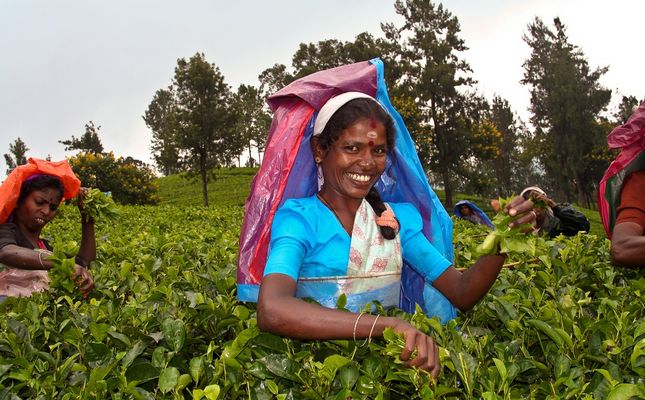[fshow photosetid=72157629781820784]
Nestled among rich, lush hills of green tea leaves, tea pickers spend all day harvesting the fragrant leaves so that they can be processed and cultivated further into the famed drink and favoured past time of many nations. Tea plantations are a major source of income for many Sri Lankans, with a majority of the workers being women. About one fourth of the country’s earnings come from the export of tea, cultivated in the rich tea plantations that cover almost the entire southern portion of the island. Among a few other commodities, tea is a major trade source for Sri Lanka, with new plantations sprouting up as recently as the mid-2000s.
History of tea in Ceylon
It all began with one single planting by Scotsman James Taylor, who in 1867 as the then superintendent of the plantation, farmed and perfected new techniques to produce superior quality Ceylon tea. The estate where he planted that first tree, Loolecondera in Kandy, symbolizes what has since become Sri Lanka’s national legacy.
After Taylor’s tenure and following his death in 1892, prominent Britisher Henry Randolph Trafford arrived as acting resident manager of several estates bought originally as coffee plantations and converted to accommodate his knowledge and expertise of the tea industry, by the 1880s, production volumes multiplied. As technology improved, government boards were established to regulate the industry and the long-standing, legendary status of Ceylon tea was born. By the year 2000, the tropical island had produced an impressive 300,000 metric tonnes per year of tea.
Tourists hotspot
The lavish expanses of abundantly green tea plants are a favourite tourist attraction, sparking a fervent interest in the trade, the country, and the individuals behind each tea leaf plucked. Visitors to various plantations have the opportunity to soak in the beautiful sights and inhale the distinct aroma of the hills and spend time at the many resorts designed to cater to such visitors.
Where in Sri Lanka is tea cultivated?
The most prevalent areas where tea plantations are harvested in the region, north to south, are Kandy, Uda Pussellawa, Nuwara Eliya, Dimbula, Uva and Ruhuna. Each area represents a unique brand, taste and style of tea leaves resulting in a wide selection of varieties. Whether a full-bodied black tea or a light aromatic blend is desired, worldwide merchants and distributors are happy with the select varietal teas available from Sri Lanka.
Kandy
Kandy was the first Sri Lankan territory to cultivate tea. Known primarily for its production of full-bodied flavours and strength, the hills of Kandy sprawl a considerable 2,000 to 4,000 feet above sea level.
Uda Pussellawa
Most unique as a result of pronounced seasons, the tea harvested in this area of Sri Lanka yields two different blends, depending on the climate. During the first quarter, when the mountainous region is cooler and drier, the tea is different from the medium-bodied counterpart that grows from mid-summer to early autumn.
Nuwara Eliya
The tea from this region embodies the aroma of cypress trees and mint, resulting in a final cup of tea that, when brewed lightly, provides a smooth and fragrant beverage.
Dimbula
This region has a weather pattern that varies anywhere from typical tropical warmth to the cool and dry weather of the monsoon season. The end product is a diverse selection of tastes and strengths. The plantations on these sites are situated well above sea level, as high as nearly 6,000 feet.
Uva
The most varied of Sri Lankan teas come from this region. Like most other plantation areas, those in Uva are located high above sea level, which lends a unique characteristic to the tea produced. The tea leaves generated from Uva are typically utilized to make other blends.
Ruhuna
With the lowest altitude of all tea-harvesting areas in the southern part of Sri Lanka, the tea plantations of Ruhuna are home to the darkest blend available. Owing to the unique nature of Ruhana’s soil, the leaves from there give off a robust taste.
Popular tea plantations in the region
With the vast area of land dedicated to this aromatic harvest, the hills and valleys in the mountainous region of Sri Lanka are operated by several tea plantation owners. Strong connections with some of the world’s finest distribution and retail establishments has made Sri Lankan tea one of the most popular drinks in the world.
Watawala plantations
Established in the early 1990s, this organization holds the distinction of being affiliated with TATA Group, owners of the famed brand Tetley®. The number of people employed by Watawala Plantations is a staggering fifteen thousand and the land mass covered by their tea gardens is as much as 12,500 hectares, or nearly 31,000 acres. Accounting for about 2% of the total tea production out of Sri Lanka, the primary form of export is via auctions.
Dilmah tea
Marketing themselves on their official website as “the first producer owned tea brand in the world, handpicked, perfected and packed at source”, Dilmah Tea represents the new generation of tea brands.
During the 1970s, the government of Sri Lanka nationalised tea plantations, resulting in 23 state-owned estates. Nearly two decades later the government allowed for the re-privatization of tea plantations in the country and despite setbacks during the time of the industry’s nationalisation, the tea trade now continues to flourish.
Tea is the second most popular drink in the world after water. Just like the most consumed beverage, tea also boasts a host of health benefits.
- The antioxidants contained in tea protect the body from the effects of pollution as well as the external aging stimuli.
- Tea keeps arteries de-clogged, which reduces the chance of stroke and heart attack.
- The tannins and fluoride found in tea deters plaque from forming in the oral cavity.
- Tea bolsters the body’s immune defenses.
- Polyphenols found in tea are known for their cancer-fighting effects.

